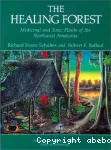Adresse
Infodoc : Réseau des bibliothèques et centres de documentation d'AgroParisTechFrance
contact
Array
(
[TITRE] => <b>Type de document : </b>
[TITRE_CLEAN] => Type de document
[OPAC_SHOW] => 1
[TYPE] => list
[AFF] => Livre
[ID] => 4
[NAME] => cp_typdoc
[DATATYPE] => integer
[VALUES] => Array
(
[0] => 5
)
)

| Titre : |
The healing forest : medicinal and toxic plants of the northwest Amazonia
|
| Auteur(s) : |
R.E. Schultes
R.F. Raffauf |
| Type de document : | Livre |
| Sujets : | 170.1 (Herbiers) Amazonie ; Brésil ; Plante médicinale ; Plante toxique ; Forêt tropicale humide |
| Résumé : |
This enormous work represents nearly half a century of field research in the Northwest Amazon encompassing parts of Brazil, Colombia, Ecuador, and Peru. While the Northwest region represents only a small part of the entire Amazonian drainage area, it is in many respects the most complex and varied part of the forest; it has also been the least studied.The authors, frorn their backgrounds in ethnobotany and phytochemistry, have included and described nearly 1,500 species and variants, representing 596 genera in 145 plant families. Of these, half have had fittle or no real investigation of their chemical and phamacological properties.The Amazon represents a storehouse of as much as 16% of the plant species existing on earth today. The native peoples of the area have retained their kn[...] This enormous work represents nearly half a century of field research in the Northwest Amazon encompassing parts of Brazil, Colombia, Ecuador, and Peru. While the Northwest region represents only a small part of the entire Amazonian drainage area, it is in many respects the most complex and varied part of the forest; it has also been the least studied.The authors, frorn their backgrounds in ethnobotany and phytochemistry, have included and described nearly 1,500 species and variants, representing 596 genera in 145 plant families. Of these, half have had fittle or no real investigation of their chemical and phamacological properties.The Amazon represents a storehouse of as much as 16% of the plant species existing on earth today. The native peoples of the area have retained their knowledge of the medicines and poisons derived frorn -this diverse flora. But as Prince Philip notes in his foreword, the plants and people of the Amazon alike are under severe pressure. The authors emphasize the importance of ethnobotanical conservation, and call attention to the fact that from these plants might come new chemical compounds of value to modern medicine and industry. It is their hope that the work will not only alert future generations of phytochemists to the potentiel of the Amazon as a source of new medicinal, toxic, or other useful compounds, but in doing so will also assist in the conservation of the folklore record of the Indian peoples concerning this richly endowed region which is so critically important to the welfare of mankind. (Résumé scannérisé) |
| Editeur(s) : | Portland : Dioscorides Press |
| Date de publication : | 1990 |
| Format : | 484 p. / ill., réf. |
| Langue(s) : | Anglais |
| Identifiant : | 978-0-931146-14-5 |
| Lien vers la notice : | https://infodoc.agroparistech.fr/index.php?lvl=notice_display&id=145794 |
Exemplaires (1)
| Localisation | Emplacement | Pôle | Section | Cote | Support | Disponibilité |
|---|---|---|---|---|---|---|
| Kourou | 1 - Facteur du milieu - Biologie | AgroParisTech-Kourou | 170.1.SCH.1990 | Papier | Empruntable Disponible |




